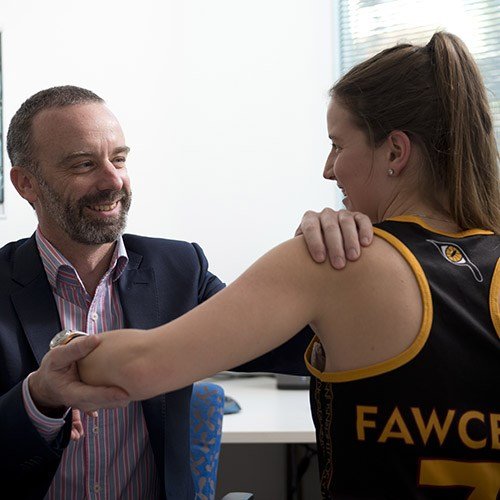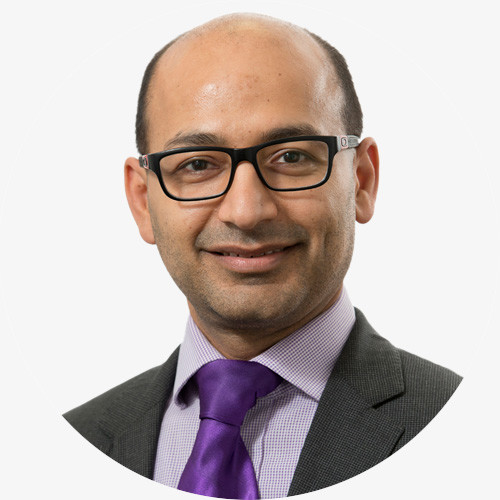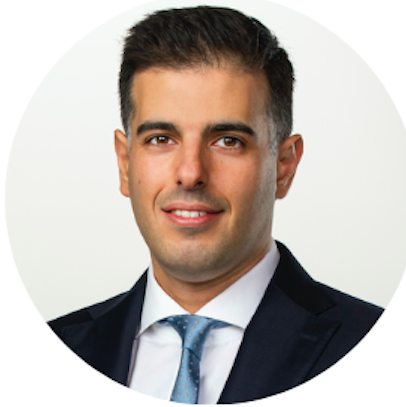
Sports Injuries
Almost every person who plays sports will be affected by a sports injury at some point in their life. These injuries can range in severity from a minor inconvenience to a life-changing incident.
Orthopaedics SA provides leading sports injury treatment across Adelaide and many regional areas of South Australia. With surgeons who specialise in treating all major joints available, you can find the one to manage your sports injury here. Many of our surgeons are avid sports players themselves, so they understand the importance of returning to a body that you can play sports well in.
Not all sports injuries need medical treatment. Many heal on their own with rest, though some need medical intervention to ensure proper healing. Consider booking an appointment with Orthopaedics SA in Adelaide if you experience the following:
- Your pain prevents you from bearing weight on the joint (like walking or lifting objects)
- Your pain lasts for more than a week
- Your pain goes away, but comes back later
- You have numbness or tingling in the affected limb
- You have shooting pain which is not localised to one region
- You can’t move or bend your joint due to pain, stiffness, or swelling
If you have pain that you cannot ignore, severe swelling, or an obvious deformity in your injured limb, we suggest presenting straight to your local emergency room for immediate treatment.
If in doubt about whether a sports injury needs orthopaedic intervention, speak to your GP about your injury and ask for their advice. You can request a referral to the orthopaedic specialists at Orthopaedics SA for expert assessment and treatment if required.
Urgent care vs. orthopaedic care
Urgent care is suitable for acute injuries that require immediate attention but are not life-threatening, such as minor fractures, sprains, and strains.
Orthopaedic care is necessary for more severe injuries pr persistent issues.
The best treatment for any sporting injury is to not get injured in the first place. There is no way to completely prevent sports injuries, but the right steps can minimise your chances and decrease an injury’s severity if one does occur. Try some of the following to prevent injuries when playing your favourite sport.
- To prevent shoulder and upper arm injuries:
Warm up your shoulders. Try a cross-body shoulder stretch or some shoulder retractions to loosen your muscles and reduce your chances of shoulder injury. - Maintain good posture. Poor posture can cause back and shoulder pain that impacts your play style. If you play sports with a poor posture, your movements may also stress your shoulders in ways that they aren’t designed for.
- Refine your throwing, bowling, or hitting technique. As well as helping your ball go faster and further, a great throwing, bowling, or hitting technique ensures that you aren’t aggravating your shoulder’s structures as you play.
- To prevent hand and wrist injuries:
Wear the right equipment. Consider using wrist guards, gloves, sports tape, or other structures to support your hands and wrists during sport. - Refine your hitting or throwing technique. Making imperfect motions constantly can lead to overuse injuries. Consider speaking to a sports coach or trainer who can help you develop the best technique possible, both for your joint help and gameplay.
- Take off bracelets and rings when playing. Jewellery around your hands can get caught or be driven into your body while playing. They can also get in the way and cause you to throw or hit a ball in unexpected ways.
- Use a closed fist where possible. Block an incoming football or serve a volleyball with a fist to avoid hurting your fingers and to reduce stress on your wrist.
- To prevent foot, ankle, and knee injuries
Wear the right shoes. Well-fitting shoes with good padding, internal support, and orthotic insoles can reduce your chances of foot pain and improve your overall form. The right shoes can reduce your chances of tripping or falling, which reduces your chance of other injuries in turn. - Run on the right surface. While not always an option, running on a synthetic surface or grass is better for your lower limb health than running on concrete. The soft surface absorbs impact and decreases muscle and joint stress.
- Refine your gait. A perfected running technique both reduces your risk of injury and improves your efficiency. Consider speaking to a sports coach or physiotherapist to develop the best technique possible.
- Play at your level. Striving for improvement and success is second nature to many sports players, so it’s easy to feel like you should challenge yourself. However, suddenly increasing your activity’s intensity subjects your body to new levels of stress and can easily cause sports injuries.Preventing re-injury
Returning to sports after an injury requires careful reconditioning. Gradually increasing activity levels, along with using protective gear, helps ensure a safe return. Following a personalised recovery plan designed by a physical therapist or orthopaedic specialist is key to minimising the risk of re-injury.Long-term injury prevention involves adopting a balanced workout routine, focusing on proper technique, and incorporating regular stretching into your regimen. Wearing appropriate gear, maintaining muscle strength, and allowing adequate recovery time between activities are essential practices that can help prevent re-injury and keep you in the game.
There are two main types of sports injuries: acute injuries and chronic injuries.
Acute sports injuries occur suddenly during physical activity and can be severe. Common examples include sprains (ligament injuries), strains (muscle or tendon injuries), fractures (broken bones), and dislocations (bones forced out of position). Immediate treatment is crucial to prevent further damage—this may include immobilisation, ice application, and seeking prompt medical attention.
Chronic sports injuries develop over time, often due to overuse or improper technique. Conditions like tendonitis (inflammation of tendons), stress fractures (tiny bone cracks from repetitive force), and bursitis (inflammation of the bursa, which cushions bones and tendons) are common in athletes who perform repetitive motions.
Almost any part of the body can be injured through sports, though some types of injury are more common than others. Below are some of the most common types of injury, along with links to where you can read more about them on our website.
Foot & ankle sports injuries
Feet and ankles see significant stress, especially in sports players. This makes them especially at risk of injuries, particularly those listed here.
· Ankle fractures – a break in one or more bones of the ankle, often caused by a high impact event such as a fall or tackle during sports. The Orthopaedics SA fracture service in Adelaide offers timely treatment for these types of injuries.
· Stress fractures – incomplete breaks in the bone causes by repetitive activity. You may be able to still walk on them as normal.
· Neuroma – one of the most common causes of pain in the ball of the foot, particularly between the third and fourth toes. It results from a pinched nerve, which can happen after repetitive stress or another injury.
· Ankle sprains – stretches or tears in the ankle’s ligaments. They are often caused by actions which suddenly stretch or tear the ligaments, such as a fall or quick change of direction while running.
· Achilles tendon injuries – Damage to the fibrous cord that connects your calf muscle to your heel bone. Rupturing it causes severe pain which will often prevent you from walking.
· Plantar fasciitis – A common cause of heel pain that usually starts as a dull, intermittent pain and progresses to a sharp and persistent one. Sports that involve a lot or running may aggravate it.
· Ankle impingement – this overuse injury is so common in sports that it’s often called ‘athlete’s ankle’. It can be aggravated by actions that move the foot upwards and downwards significantly, such as kicking a soccer ball or running with poor form.
· Heel spurs – these hard calcium deposits often occur alongside plantar fasciitis. They can cause extreme pain in the rear foot while standing or walking.
· Ankle dislocations and instability – these may result from a sharp blow or fall (such as tripping or being tackled) or can sometimes follow another injury which did not heal correctly.
· Metatarsal fractures – breaks in the bones that make up your foot. These are one of the most common foot injuries, often resulting from a direct blow to the top of the foot (such as being stepped on or crushed under something heavy)
Knee sports injuries
The knee is easily the most commonly injured joint in sports and is one of the most complex joints in the whole body. Many Orthopaedics SA surgeons hold particular subspecialties in treating knee injuries, including the ones listed here.
· Knee fractures – these can be caused by a sharp blow or other high-impact event to the knee. Orthopaedics SA operates a specialised fracture clinic in Adelaide which efficiently treats these injuries.
· Knee ligament injuries – damage to any of the four main ligaments in the knee, usually causing severe pain and inability to walk. They include anterior cruciate ligament (ACL) and posterior cruciate ligament (PCL) injuries.
· Patellofemoral pain – often called ‘runner’s knee’, patellofemoral pain starts at the front of the knee and may spread around and to the back of the kneecap. It can result from repetitive knee-bending motions, like running or doing squats.
· Jumper’s knee – an inflammation of the patellar tendon which is caused by overuse. As the name implies, it’s especially common in athletes who jump often in their sports.
· Meniscal tears – these happen when the piece of cartilage between your thigh bone and kneecap, called the meniscus, pulls away from the bone. You may hear a popping sound when it happens, followed by gradually increasing pain and stiffness over several days.
Hip sports injuries
Hip injuries are one of the less common orthopaedic injuries in sport, but occur nonetheless. Orthopaedics SA proudly operates a dedicated hip service for treating all manner of hip injuries, including:
· Hip fractures – more common in older individuals or those affected by bone-weakening conditions like osteoporosis, hip fractures can happen due to a sharp blow or a fall during sports. Orthopaedics SA operates an Adelaide fracture centre for managing injuries such as these.
· Trochanteric bursitis – this type of bursitis affects the fluid-filled sac on the outside of your hip joint (the greater trochanter), and can cause any hip movement to be painful. It most often develops due to overuse.
Shoulder and elbow sports injuries
Shoulder injuries are a little more common than elbow injuries in sports, though both are frequent in high-impact sports and ones that involve repetitive arm movements. Seeing a surgeon who specialises in shoulder or elbow surgery can greatly improve your ability to recover from any of the following conditions.
· Biceps tendinopathy – pain and tenderness in the biceps muscle, usually caused by wear and tear. Repetitive overhead motions, like bowling overarm or hitting high balls in tennis, can cause and aggravate it.
· SLAP lesions – SLAP tears are injuries to the labrum: the ring of cartilage around the shoulder’s ball-and-socket joint. They are often caused by overuse, though sudden shoulder trauma may cause them as well.
· Rotator cuff tears – tears to any of the major tendons which make up the shoulder joint. They can be caused by repetitive overarm movements (like bowling overarm), or sudden blunt force trauma (like landing on your arm or shoulder after being tackled).
Shoulder and elbow sports injury
· Shoulder impingement – a term used to describe a number of shoulder conditions, including rotator cuff tears. It’s usually characterised by difficulty and pain in the shoulder when raising your arm. It’s often caused by overuse, but acute injury can sometimes cause it also.
· Golfer’s elbow – develops when repeated muscle contractions cause tiny, painful tears in the tendons that attach to your elbow. It’s especially common in golfers, as the name suggests, but can also affect people who pitch or bowl overarm.
· Tennis elbow – similar to golfer’s elbow, but occurring on the outside of the elbow as opposed to the inside. Tennis elbow is usually caused by overuse of the forearm muscles, so it can impact anyone who plays racquet sports.
Hand & wrist sports injuries
Hand and wrist injuries are among the most common injuries overall – not just in sports. There are many small bones and important structures in the hand and wrist, so these injuries are often best treated by a specialised hand surgeon.
· Carpal tunnel syndrome – nerve compression or pinching inside the carpal tunnel, which is a passageway in the wrist where the median nerve and several tendons sit. It may be caused or aggravated by repetitive movements, such as swinging a tennis racquet or golf club.
· Hand and wrist fractures – these fractures are easily sustained in all kinds of sport: anything from jarring a finger to a fall onto an outstretched hand can cause them. They are characterised by severe pain and often deformation in the hand or wrist.
When you seek medical attention for a sports injury, your GP or emergency room doctor will usually carry out a physical exam. They may ask if you can move your injured limb in certain ways, or ask you to attempt specific actions which help them understand the cause of your pain.
If they suspect a significant injury, your GP will often request X-rays to look for obvious structural damage. They may also ask for ultrasounds, MRIs, or other scans used to see potential soft tissue damage. Any injury that needs specialised support will usually get referred to an orthopaedic surgeon.
Your orthopaedic surgeon diagnoses a sports injury in much the same way as your GP, though they do so with a greater knowledge of what could be wrong and how they can help you heal. They will look for pain, swelling, tenderness, unusual looseness (laxity), and deformity. These are all signs of damage to the ligaments, cartilage, and other tissues which might need help to heal.
If the surgeon feels that surgery is the best course of action, they will ask for more imaging tests. This usually includes an MRI, sometimes accompanied by more x-rays and other tests that look at various bodily structures. Your orthopaedic SA surgeon then uses this information to plan the best possible course of treatment for your sports injury.
Treatment depends on the type of sports injury you have, the area in which it is located, and the injury’s severity.
If your GP suggests seeing a specialist in sports injuries, ask for a referral to Orthopaedics SA. Our diverse team of surgeons have a wide range of specialties, so we can match you with the surgeon who is best qualified to treat your injury. With locations all across Adelaide and regional South Australia, we can also help you find a surgeon who is close to home.
Most sports injuries – especially minor ones – heal well without surgery. Our orthopaedic specialists may guide you to support the injury effectively, minimise pain during the recovery process, and give instructions on how to restrengthen the limb when it’s time to get back to sports. They can also connect you to other relevant specialists (like physiotherapists) who will provide ongoing support.
Proper assessment is the first step in any recovery process. If your injury warrants medical intervention, see an Orthopaedics SA surgeon at a convenient Adelaide location for individualised advice. If you are unsure about your sports injury’s extent, see your GP for advice and ask for a referral to Orthopaedics SA.
If your injury needs orthopaedic surgery to repair, you can expect at least a few weeks away from sport while recovering. Larger surgeries may need up to 12 months of recovery time, and your injured limb may not perform exactly the same as it did before. Our team will work with you to devise a strategy that gets you back to playing the sport you love – this may include modifying your play style or how often you play.
Physical Therapy
Physical therapy plays a crucial role in recovering from sports injuries. It helps restore strength, flexibility, and function in the affected area. A well-structured physical therapy program can reduce pain, improve mobility, and prevent future injuries, ensuring a safe return to physical activity.
Common rehabilitation techniques
Rehabilitation typically includes a variety of exercises and therapies tailored to the specific injury. Stretching exercises maintain flexibility, strength training builds muscle support around the injury, and range-of-motion exercises improve joint mobility. These techniques are essential for regaining full function and preventing complications during recovery.
Following a sports injury, the best way to prevent ongoing problems is to properly rest during recovery and to find a surgeon who knows your condition well. For optimal support in your recovery, call Orthopaedics SA to find an Adelaide orthopaedic who can give the right advice for you.
Book appointment
Book appointment













